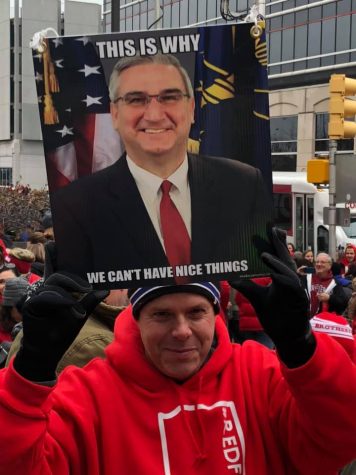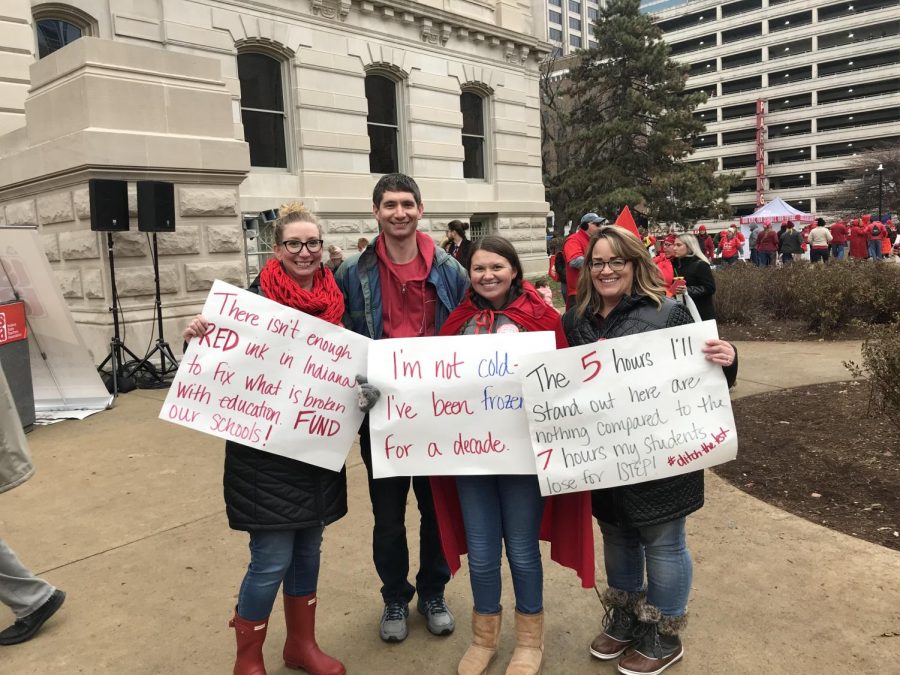Sea-ing Red in Indy
November 22, 2019
Indiana’s educational system had many in Indianapolis seeing red Tuesday, as tens of thousands of educators from across the state gathered in protest to voice their concerns over working conditions and wages for one of the most under-appreciated professions in the nation.
In all, 147 school districts opted to close for the day, unable to muster enough of a workforce to fill the classrooms. Elkhart Community Schools was among them. Of the roughly 232 from this corporation joining in the campaign, at least 45 were from Central. Although the day will be counted as an emergency makeup day—replacing the one scheduled for Feb. 14—it was well worth it, according to those who attended the event.
“I am here every day to teach,” explains math teacher Linsday Nilsen, “but this is one day—one day to say: Hey, I’m here and I have a voice!”
Steven Starzyk, history and psychology teacher, helped orchestrate a poster-making campaign here at Central to help voice the frustration felt by him and so many of his co-educators. “What a great day!” he shares in an email to his co-workers the following day. “I truly believe we made an impact.” The movement has gained so much support from fellow teachers to students that it has been dubbed the Red for Ed Action Day.
Public education has always had its problems, teachers note, but for many now is the time to finally come out and voice their concerns. Paul McCelland, chemistry teacher, is among them. “In the ten years that I’ve been teaching,” he declares, “it has been ten years of struggle. The education system has struggled to provide adequate resources my entire career.”
Essentially, teachers assert that the state hasn’t properly addressed the public education problem for a decade, creating a growing issue. Around 81% of Hoosier residents attend public school, according to EdChoice.org. This means that the problem affects the majority of Indiana residents and, therefore, should have been addressed long before it got to this crisis point.
Few would argue that being a teacher is a service and an honor. Educators are responsible for molding and shaping the future’s minds. The future generation depends upon these individuals. Doctors, lawyers, physicists: They all start out learning how to read and write; all taught by these humble workers. Therefore, it is imperative that they receive the basic necessities they ask for. Olivia Miller, 10, urges the community to take action. “It’s important that these educators get what they need. Without them we wouldn’t be able to function. Who would teach our elementary students?” she adds. “How would we learn? In all honesty,” Miller concludes, “we take them for granted.”
After a decades-long career, the national average salary for teachers is $60,477—whereas the average for the state of Indiana is $54,308. This may seem plentiful to those earning less; however, after paying for a four-year college degree and earning a starting salary of less than $35,000, the state and national averages look less enticing. On top of that, many teachers—due to poor funding—go out of their way to provide supplies needed for the classroom. Even these out-of-pocket expenses for essentials are often not enough. According to business insider, around 94% of teachers pay out-of-pocket for school supplies. This is a major indicator that the education system is not sufficiently providing basic classroom necessities.
In the past, teachers have made attempts to reach out to legislation to make changes, but this was to no avail. Finally, educators collectively decided to rally to make their demands heard. What was once a yelp is now a cry for help—for change in Indiana’s education system. The rally of teachers who made the commute to Indy on the 19th displayed their commitment and determination to strive for better.
“Teaching isn’t an easy job,” Nilsen reminds all. “I’m here every day to teach and educate. I can’t do that without the help of the State. It’s hard as it is, so now’s the time for action.” Thousands of teachers did not just go to plead for better pay, they went to prove a point and stand up to legislators. Many school administrators, such as those at Elkhart Central, recognize their teachers’ plight. “Administration is behind us,” McClelland notes, “and they support us. Teachers teach because we want to serve, and the state is not helping us.” Among the administrators attending were Dr. Thalheimer, Dr. Sheppard, and Tony England, as well as School Board President Doug Weaver.
In an effort to keep the protest in the public eye, every Wednesday teachers can be seen wearing the color red. It has become a symbol for the movement. It represents their fight, whether it be for school nurses or better salaries. Essentially, the color has become a statement of what can be described as the fight for the greater good. “I truly believe we made an impact,” asserts Staryzk. “However, this is just the beginning of what needs to be done—and we will all have a role to play in the outcome for publication education in our state.”
In the end, it is up to Indiana legislators to admit that the current education system is not working and enact change. As seen by this week’s protest, no longer will educators’ voices be silenced and ignored. Their message is clear: Now is the time to finally value an educator’s contribution to society—words are no longer enough.









